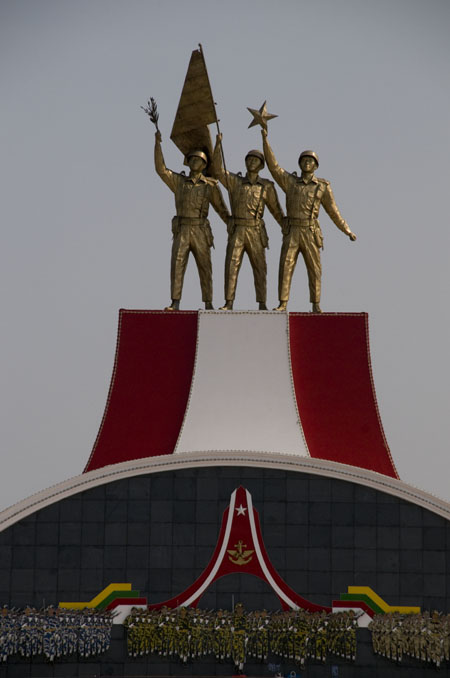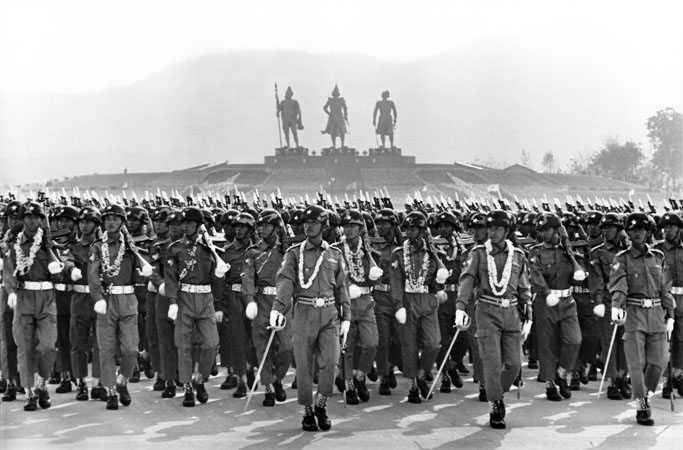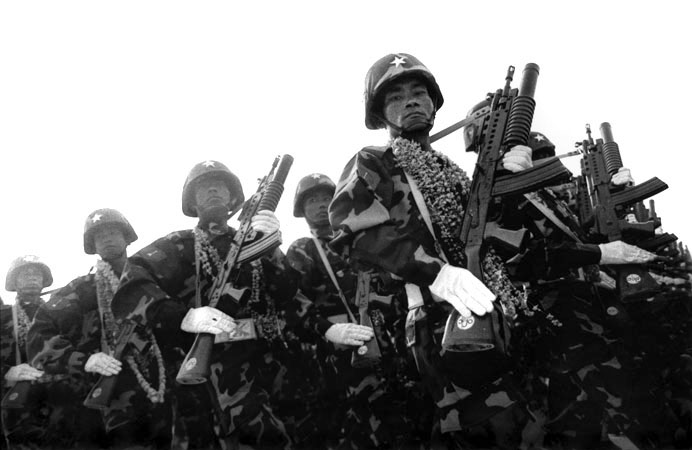Readers of New Mandala will doubtless be familiar with Nic Dunlop’s iconic photograph of the 10-metre high statues of Burma’s three warrior kings (Anawratha, Bayinnaung and Alaungpaya) which tower over the main parade ground at Naypyidaw. On a recent visit to the capital, however, the Bangkok-based author, photographer and film-maker took a picture of another statue which is less well known.
This other statue, which stands in the grounds of the enormous new Defence Services Museum, consists of three life-size figures. One holds aloft a leafy branch, another raises a five-pointed star, and the one in the middle carries an unfurled flag. As seen in Nic’s photo below, the statue’s massive red and white pedestal surmounts a large white star, above the emblem of Burma’s armed forces (Tatmadaw).
Photo of statue, by Nic Dunlop
This striking triptych does not appear to be identified in any way, raising a number of questions not only about the meaning of the statue itself, but also the symbolism of each component part. It is possible to read too much into such public displays but, by looking back through modern Burmese history, a number of possibilities present themselves.
Judging from their uniforms and military helmets, the three figures are soldiers. Taken together, they probably represent the Tatmadaw. It is curious that these figures are not portrayed in a way that better illustrates the three services, namely the army, navy and air force, but perhaps the designers of the statue wanted to emphasise that each figure had the same symbolic significance.
The figure on the left could be holding up a branch of the padauk tree, long revered by the Burmese for its strength and durability. Alternatively, it could be a sprig of laurel leaves, which represents victory in most Western cultures, or even an olive branch, universally known as a symbol of peace – as seen for example in the seal of the United Nations.
Another, albeit less likely, explanation is that the soldier is holding up a sheaf of rice, Burma’s staple crop and – under Ne Win’s socialist regime – used to represent the country’s peasants. Together with a pinion, or cog-wheel, symbolising the workers, a stalk of rice figured on the national flag which was used from 1974 until 2008. During this period, the state seal included two ears of rice surrounding a cog-wheel and an outline map of Burma, flanked by two chinthes.
After promulgation of the 2008 constitution, Burma adopted a new flag and state seal. On the latter, the map of Burma which makes up the central motif is surrounded by two (indeterminate) leafy branches. Since at least 2002, similar branches have bracketed the Tatmadaw crest on the cap badges of military officers. Police cap badges are different, but they too incorporate garlands of leaves. However, it is not clear what kind they are.
The five-pointed star has a long history in Burmese iconography. During the Second World War, the nationalist Burma Independence Army and Burma Defence Army wore the star of the Imperial Japanese Army on their caps. After Burma’s nominal independence in 1943, officers of the renamed Burma National Army seem to have worn the traditional peacock emblem, but most soldiers retained the star.
A white five-pointed star also appeared on the red banner of the Resistance or Revolutionary Army, later called the Patriotic Burmese Forces (PBF), which General Aung San led against the Japanese, after striking a deal with the invading Allies in March 1945. After Burma regained its independence in 1948, the same flag seems to have been adopted as the flag of the new Burma Army.
The first national flag of independent Burma incorporated a large star surrounded by five smaller stars. The large star stood for the unity of the nation. The smaller stars stood for five of the constituent parts of the Union, as outlined in the 1948 constitution, namely Shan, Kachin, Karen and Kayah States and the Chin Special Division. All the stars were coloured white to denote truth, purity and steadfastness.
After the 1962 coup, Ne Win’s Revolutionary Council adopted a red flag with two overlapping white stars in the canton. This design was clearly derived from the PBF and Burma Army flags.
On the flag of the Socialist Republic, introduced in 1974, the Union star of the democratic era was replaced by the cog-wheel and rice device, to denote workers and peasants. However, the flag incorporated fourteen small stars, representing the country’s seven states and seven administrative divisions. The regime also added a large star to the national seal, replacing a third chinthe which had stood above the central motif.
It might also be worth recording that leftist groups in Burma set aside the hammer and sickle (used, for example, by the nationalist Dobama Asiayone during the 1930s) in favour of stars on their flags. The two main factions of the Burmese communist party adopted different coloured flags, but both included a large star and three smaller stars – presumably representing the party and three classes identified in communist doctrine.
And, of course, since September 1988 the flag of the National League for Democracy, of a fighting peacock on a red field, has had a white, five-pointed star in the canton.
The national flag devised by the SPDC for the new Republic of the Union of Myanmar, and formally adopted in the 2008 constitution, is based on the yellow, green and red tricolour used by ‘independent’ Burma during the Japanese era. Instead of a central peacock device, however, it has a large white star, presumably representing the Union.
The Tatmadaw has always used the five-pointed star as a symbol. In addition to the Resistance and army flags, mentioned above, the formal crest of the armed forces has a large star representing the Union, above symbols of the three separate services – wings for the air force, an anchor for the navy and a smaller star representing the army. Several regional military commands incorporate stars in their flags and shoulder patches.
The timing is unclear, but the SLORC seems to have changed the Burma (now Myanmar) Army crest and flag to the now familiar red and white device showing a traditional Burmese (‘Bandoola’) helmet crossed by a spear and dah (sword). The naval ensign and air force flag, however, still incorporate white stars. Burmese soldiers and policemen still wear a white star on their helmets.
To return to Nic Dunlop’s photo of the mysterious statue at the Defence Services Museum in Naypyidaw, the flag being held by the central figure is hard to identify. It could be the flag of the armed forces, but is more likely to be the new national flag. Like governments the world over, Burma’s military regime has consistently used the flag to represent the country, in particular its national sovereignty.
With all these factors in mind, a possible explanation of the statue presents itself. Could it be a graphic, if rather grandiose, representation of the former regime’s three ‘national causes’, which were promoted endlessly by the SLORC and SPDC through public propaganda campaigns, school education programs and military indoctrination courses? Stated briefly, these were stability, unity and national sovereignty.
Photo of Myanmar Police Force personnel on parade in front of the three kings statue, by Nic Dunlop
In 2008, these three national causes were elevated to the level of ‘basic principles’ and, along with three others (such as the Tatmadaw’s national leadership role), were enshrined in the new constitution. They thus remain relevant to the hybrid civilian-military parliament ‘elected’ in 2010 and the government formed by President Thein Sein in 2011.
Applying this logic to the statue, the branch could be a sprig of olive, representing peace (or, in the regime’s parlance, internal stability). Based on its past use, the star most likely represents the unified country (the Union), while the flag probably represents Burma’s national sovereignty and independence.
Photo of Myanmar soldiers with star on the helmets, by Nic Dunlop
If this is a correct reading of the statue’s meaning and motifs, then the military garb of the three standing figures most likely represents the Tatmadaw’s perceived central role in promoting and safeguarding these three causes. Such an interpretation is also supported by the nature of the symbols found on the statue’s massive pedestal.
All this is rather speculative, however, and begs some hard facts. If any New Mandala readers can identify this particular statue, or can add anything to the train of thought which has led to this conclusion, comments would be most welcome.
Dr Andrew Selth is a Research Fellow at the Griffith Asia Institute.
 Facebook
Facebook  Twitter
Twitter  Soundcloud
Soundcloud  Youtube
Youtube  Rss
Rss 

